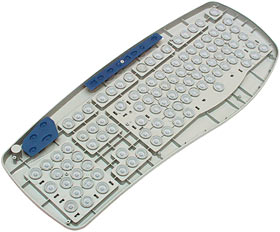
Atomic I/O letters column #73
Originally published in Atomic: Maximum Power Computing Last modified 16-Jan-2015.Square card, round case
In the "Extreme" category of the Atomic KitLog section [in which Atomic gives a component breakdown for a "Budget", "Performance" and "Extreme" gaming PC, every month] you list the Lian Li PC-S80 case and GeForce 8800 GTX graphics cards.
I was very interested in building this PC, but the Lian Li case doesn't seem to be able to accommodate the 8800s. My question is why?
Patrick

...and the 8800 GTX/Ultra.
Two great tastes that go together like sausages and ice cream.
Answer:
You're right. The motherboard area of the S80 is just barely - only a few millimetres
- too small to fit the 26.7 centimetre length of a standard 8800 GTX circuit board.
The drive bays are a hair too close to the back of the case.
Here's a thread about this, including information about lots of cases, and neat-o pictures with rulers and card silhouettes.
It's possible to get around this problem if you've already got an S80, by moving the drive cage a bit. It's riveted in place, but you could drill out the six aluminium pop rivets, make four new holes to shift the drives a little closer to the cooling fans (or extend the existing holes into slots), and bolt or rivet the bays back in place. That'd probably do it.
Or you could do it the nastier way and just chop out the aluminium side of the drive cage where it lines up with the card. You might end up having to reinforce what was left, though.
None of this is really worth doing if you don't have an S80 already, of course. Get some other case.
Any ordinary tower case with no drive bays in front of the motherboard slot area should be able to accept big cards, but there are still many cases that can't. This is because normal home and office users have, historically, almost never used big cards, so it's pretty safe for case manufacturers to put extra 3.5 inch bays or something in that space instead.
The sudden (relative) popularity of the 8800 GTX has brought this to people's attention - including the attention of the Kitlog editors, who have now, ahem, revised the hardware configuration for the Extreme system, and set about hiring civilian contractors to dispose of anybody who remembers their error.
The 8800 GTX isn't, actually, that huge. Full length PCI cards can have PCBs up to 312 millimetres long, and full-length ISA cards, back in the mists of time, were even longer.
Anybody rich enough to purchase an IBM Professional Graphics Controller back in 1985 (inflation-adjusted list price: $US8000) got two 33.5cm ISA cards and a smaller daughterboard for their money!
Never rule out goblins
Since early December, my PC has been suddenly blacking out and restarting itself. It doesn't give me any warnings like a shutting down screen or Remote Procedure Call shutdown message, but sometimes I get a static noise or a beep through my speakers as it happens.
It generally occurs when the PC is under load. Also, it seems to occur more frequently during the day and (this may sound strange) even more frequently when the weather's warm. Yet during the night or cooler weather it can run fine under load. Windows Memory Diagnostic showed up clean, plus my box is well ventilated with plenty of fans and is not choking on dust.
I remember hearing somewhere that in times of peak electricity usage (such as hot days) the power grid can have trouble coping with demand and as a result, drops a few volts/amps. Is this true? If so, could this (along with my PSU being nearly 2 years old) be contributing to the problems I'm having? Would a new PSU help the problem?
Antony
Answer:
Yes, it is possible that your PSU is at fault. There's no limit to the weirdness that
can be caused by a faulty power supply.
PC power supplies that're working properly, though, can handle quite a lot of bad behaviour on their input side, and the symptoms you're reporting point in a different direction.
There's actually, you see, nothing even slightly strange about a computer that dies when it's warm. The usual cause, once you've eliminated vast fields of gently waving dust, is a bad CPU or motherboard-chip cooler.
Modern PCs can pretty much all sound an alarm when the CPU temperature exceeds X degrees, or when the CPU fan speed drops below X RPM. But the alarms are often turned off in the BIOS setup, if only to avoid novice users freaking out when they plug the CPU fan into a different header, resulting in everything actually being fine, but the unconnected header now reading zero RPM.
You can easily check CPU temperature in Windows with a variety of software. The kids are mostly using SpeedFan these days, and that'll give you an idea of how hot your CPU is. The maximum junction temperature for modern CPUs can actually be up around boiling point, but even those processors can be expected to get flaky when their temperature sensor reports more than 80 degrees.
If the CPU's cool, a motherboard chip cooler, or possibly even a graphics card cooler, may be the culprit.
Cooler performance deteriorates if the heat sink is full of dust (which isn't necessarily easy to see), if the fan is on the way out, or if the thermal interface material material between the heat sink and the chip is drying out or otherwise compromised.
All of these problems are pretty easy to solve. Most CPU coolers use common fan types, and small chip cooler fans can be replaced with larger ones lashed up somehow to blow on the now-fanless heat sink. You can replace bad thermal material by removing the cooler, scraping off the old stuff (naphtha Zippo-type lighter fluid is a good solvent for stubborn "chewing gum" thermal goop), and replacing it with a smear of ordinary cheap white thermal grease.
Yes, there are ten thousand exotic thermal goop formulations out there, but the cheap white stuff is within a few percentage points of all of them. Slightly more expensive silicone-based white stuff will resist drying out for longer.
[Antony finally figured out his problem: His motherboard was defaulting to running his memory at 3-2-2-5 timings, rather than the faster 2-2-2-5 it said on the sticker. For some reason, speeding the memory up solved the problem.]
Not as l337 as he sounds
I'v3 got a k3yboard that has on3 k3y that do3sn't want to work.
Gu3ss which k3y.
I'm d3finit3 that it's not contacting th3 part und3rn3ath corr3ctly. Is th3r3 an 3asy way to fix this?
(I don't want to buy anoth3r k3yboard b3caus3 I had 3nough troubl3 finding a g3n3ric USB k3yboard that's silv3r/black). I'm r3moving th3 markings from 3ach of th3 k3ys so I can hav3 my own Das K3yboard.
Morris
Answer:
It depends on the keyboard, and also on your definition of "easy".
Most keyboards today are of the rubber dome type. In the simplest and cheapest version, as seen in remote controls and very bad PC keyboards, the plastic key pushes down a rubber dome, on the underside of which is rubber peg with a conductive coating, which bridges traces on a plastic membrane to make the contact.
When this sort of keyboard goes bad - as it often does, in remote controls - you can fix it by simply re-coating the bottom of the offending key's contact peg with a conductive substance, like glued-on aluminium foil. Just scribbling on the peg with a lead pencil is often good enough, and will really impress your grandma.
The most common keyboard design today is the improved "dome membrane" type, which is a hybrid of the basic rubber dome and the reliable, but awful to type on, "membrane" keyboard, as seen on microwave ovens and the Sinclair ZX81.
In dome membrane keyboards, the dome bends a top membrane, through a hole in a spacer, onto a bottom membrane. When traces on one membrane touch traces on the other, you get your keypress. Problems arise if the traces on one or both membranes get worn or dirty.
The two membranes and the spacer are each a separate sheet of plastic, and you can remove and replace them - or at least fan them out like the pages of a book for cleaning - quite easily once you've found all the screws that hold the keyboard together.
Take the 'board apart and remove the membranes, wipe down the contact faces with a damp cloth, then check for any remaining crud and damage on the contacts for the offending key(s).
Some keyboards let you easily lift off the whole dome-and-key assembly; others make it more challenging, especially the ones that have a separate piece of rubber for each dome instead of one big sheet.
The best way to avoid millions of key-parts cascading onto the floor is to think carefully about which way up you should hold the keyboard for each stage of the operation. It's seldom a good idea to turn the keyboard right-side-up again until you've finished reassembling it.
Wanted: 5GHz Northwood
In your very first Ground Zero column, "Learning to love depreciation", you said:
"2GHz is probably the fastest P4 you're ever going to plug into a Socket 423 motherboard. Then, it's Northwood all the way."
I'm running WinXP Pro SP2, using a 2.8GHz Socket 478 P4 with 512K cache (800MHz), plugged into a Gigabyte GA-8IPE1000 Pro2 with 1.5Gb of Kingston dual channel DDR400 RAM. Very soon I want to upgrade my PATA hard disk drives to twin 320Gb SATA Seagate Barracudas, because I'm getting into some (legitimate!) DVD replication.
I've also optimised with latest BIOS, drivers, patches, etc.
My question: What's the fastest Intel CPU I can put in this motherboard?
Peter
Answer:
You can't get anything that'll be a whole lot faster than what you've got already.
The 800MHz-bus 3.4GHz P4 Extreme Edition is the fastest-at-stock-speed Socket 478 chip that will ever exist. But there are 3.2 and 3.4GHz Prescott and Northwood-core P4s as well. I'd have one of those, personally.
The Extreme Edition has the weird "Gallatin" core with Level 3 cache, which can make it (just) perceptibly faster for some tasks than an equivalently clocked Northwood or Prescott. The difference at a given clock speed really isn't noticeable for most purposes, though, and the plain Northwood core runs considerably cooler.
Northwoods are also more overclockable than Prescotts and Gallatins, all things being equal, but you shouldn't expect much overclocking headroom from any P4 with a sticker speed above 3GHz. Well, not without heroic cooling, anyway - yes, I know about those nuts who got a P4 up to 8GHz with liquid nitrogen.
If your existing 2.8GHz chip has 512k L2 cache, as you say, then it's a Northwood and should be quite happy running at 3.2GHz or something. Then, there'll be bugger-all difference between it and any new, higher-sticker-speed Socket 478 CPU you care to name.
Even at stock speed, your 2.8GHz Northwood will get better than 0.7 times the benchmark results of a 3.4GHz Extreme Edition chip for most tests, so it's not worth getting the faster chip unless it costs close to nothing.
The 3.4GHz EE P4 has plummeted in price now that all of the overclockers are stampeding into cheap quad core, but it's still at least $US250, as I write this (it was still about $US700 when I first wrote this for print, back in February 2007!). So I doubt you're very attracted to it.
If you had an old 2GHz-or-worse CPU then upgrading to 3GHz-or-better could give you a real performance boost. 3GHz-ish Northwoods are still widely available, and very good value.
There's just not much more than that to be had, though.




